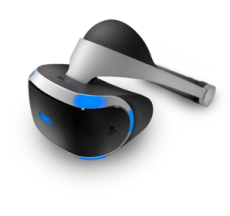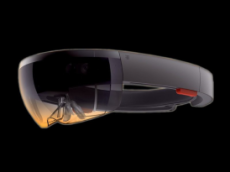Lab Overview
Headsets

Oculus Go
Similar to the Mirage Solo, the Oculus Go is an untethered headset that functions independently from outside sources, such as a phone, PC, or console. It can connect to the wifi, and can store 64 GB of data. It is much more mobile than the Oculus Rift, but since it doesn’t use positional tracking (the Oculus Rift does this with a motion camera), moving backwards and forwards in the virtual space is impossible.

Oculus Rift
The Oculus Rift is Oculus’s highest-end VR headset. It must be plugged into a PC with a motion camera to function properly. It is one of the more popular gaming VR headsets on the market.

Magic Leap
The Magic Leap is a AR Headset that does not require a tether to a PC. It does however need to be tethered to a Lightpack: a fairly large disk that the user places in a sling across their body. The MagicLeap features brighter colors and a wider field of view than other AR glasses before it.

Windows MR Headset
The Acer Windows MR Headset is a VR headset (not AR) developed by Acer and Microsoft. It is relatively low priced compared to other PC VR headsets.

Vive
The VIVE headset is one of the more popular gaming VR headsets on the market. The motion camera is mounted to the wall and takes advantage of whole-room VR, however the headset must still be tethered.

Playstation VR
Playstation VR is Sony Playstation’s one and only VR headset. It is only compatible with the Playstation Pro. It must use a motion camera to function. It is one of the more popular gaming VR headsets on the market.

Lenovo Mirage Solo
Yet another step up from the Google Daydream, the Mirage Solo allows users to use Daydream apps without having to use their smartphone. The Mirage Solo is an untethered headset that functions independently from outside sources, such as a phone, PC, or console. It can connect to Wi-Fi and hold up to 64 GB of memory. It can even use positional tracking, unlike the Oculus Go, so that users can move forwards and backwards in virtual space.

Google Daydream
A step up from the Google Cardboard, the Daydream can play all Google Cardboard compatible apps, as well as apps specifically created for the Daydream. There is an adjustable strap to keep the headset secure on the user’s head. The Google Daydream also includes a handheld remote control for more interactivity.

Google Cardboard
This is a very low cost headset, made from cardboard. The user must hold the headset to their face to use. This headset uses your mobile phone to project most VR mobile apps.

HoloLens
The Hololense is one of the first commercially available sets of AR glasses on the market. It is untethered, but the glasses are fairly bulky.

HoloLens 2
An ergonomic, untethered self-contained holographic device with enterprise-ready applications to increase user accuracy and output. Fully articulated hand tracking, touch, grasp, and move holograms in ways that feel natural. HoloLens 2 adapts to your hands, so holograms respond like real objects.